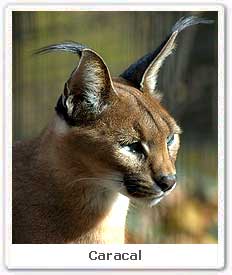| Kingdom : | Animalia |
| Phylum : | Chordata |
| Class: | Mammalia |
| Order : | Carnivora |
| Family : | Felidae |
| Subfamily : | Felinae |
| Genus : | Caracal |
| Species : | C.caracal |
| Zoological name : | Caracal Caracal |
| Found In : | Panna National Park, Sariska Tiger Reserve, Ranthambore National Park |
 Physical appearance : Caracal is 52 inches long and
weigh around 50 pounds. They have long slender body with total height of
about 20 inches. They have pointed and narrow black ears. Males are larger
than the females. The fur of the caracal is reddish brown in colour. Under
parts of the chin and body are white and the narrow black eye runs from the
corner of the eyes to the nose. The size of its tail is around 30 cm. They
have long legs and are excellent climbers. It is the heaviest and fastest of
all small cats.
Physical appearance : Caracal is 52 inches long and
weigh around 50 pounds. They have long slender body with total height of
about 20 inches. They have pointed and narrow black ears. Males are larger
than the females. The fur of the caracal is reddish brown in colour. Under
parts of the chin and body are white and the narrow black eye runs from the
corner of the eyes to the nose. The size of its tail is around 30 cm. They
have long legs and are excellent climbers. It is the heaviest and fastest of
all small cats.Presence in India : Caracal is found in Rajasthan, Gujrat and the Western parts of Madhya Pradesh. They are also spotted in Panna National Park, Sariska and Ranthambore Tiger Reserve.
Species : Caracal caracal caracal, Caracal caracal algira, Caracal caracal damarensis, Caracal caracal limpopoensis, Caracal caracal lucani, Caracal caracal michaelis, Caracal caracal nubica, Caracal caracal poecilotis, Caracal caracal schmitzi
Habitat : Caracal prefers scrubby and arid habitats. They are also found in the evergreen mountainous and tropical rain forests. It lives upto an altitude of 3000 meters.
Diet : Caracal is a carnivorous and preys upon rodents, hares, hyraxes, birds, jackal, mongoose, mountain reedbuck, small antelope, hedgehog and baby impala. It also eats feathers of small birds. Caracal can survive without the water for the longer period. It mainly haunts during the night time.
Reproduction : Caracal attain the sexual maturity between 12- 16 months. They have the capability to breed throughout the year. Female usually mates along with the three males. The gestation period rests for 78- 81 days. Females produce a litter of 1- 4 kittens., with 2 being the average. Young ones are born blind and helpless. They are reddish brown in colour. They open their eyes in 6-10 days. They remain with their mothers for about an year and are weaned at 10 weeks.
Conservation status : (Least concern).The Soviet Central Asian subspecies has an IUCN listing as rare. All Asian populations have a CITES appendix 1 listing. Caracal is being widely haunted for its skin. They are mostly killed for livestock predation. It is also haunted for games and sports.
Lifespan : Lifespan of the Caracal exceeds upto the age of 19 years.






